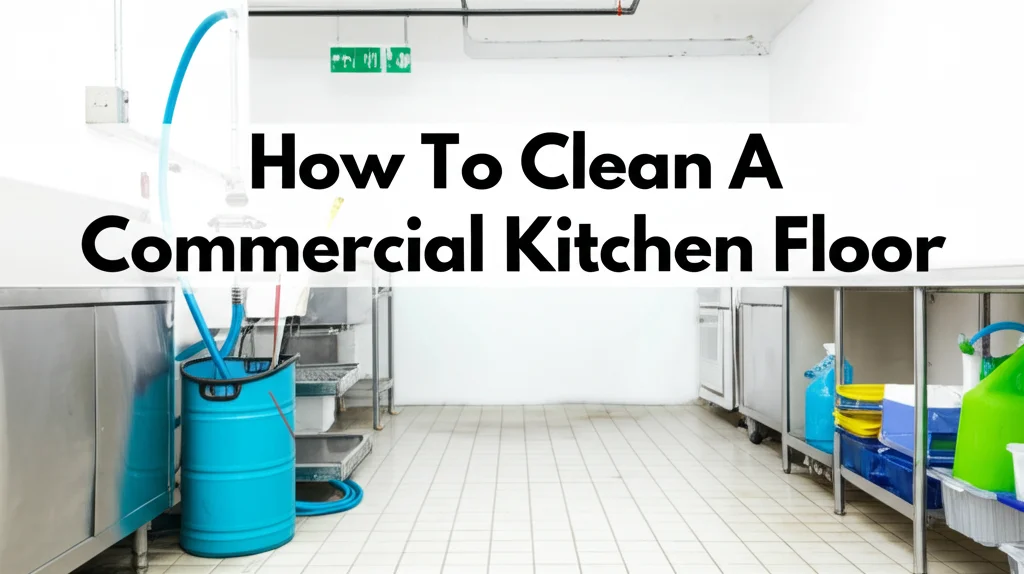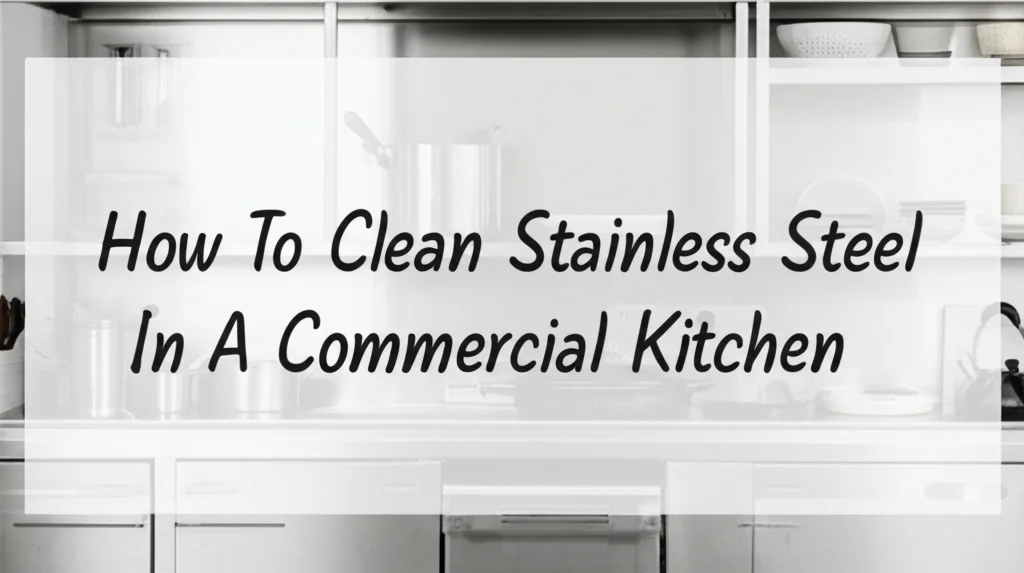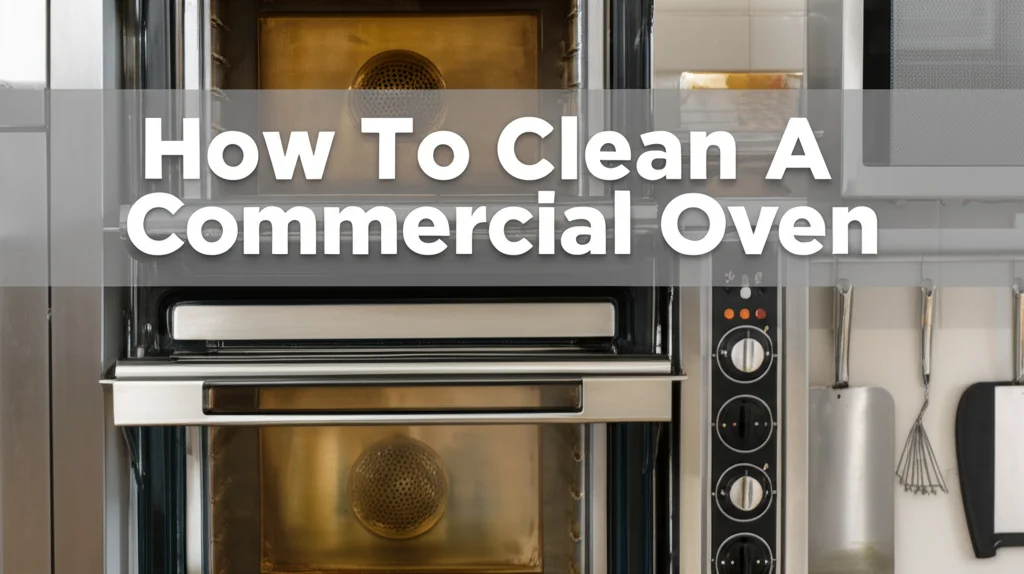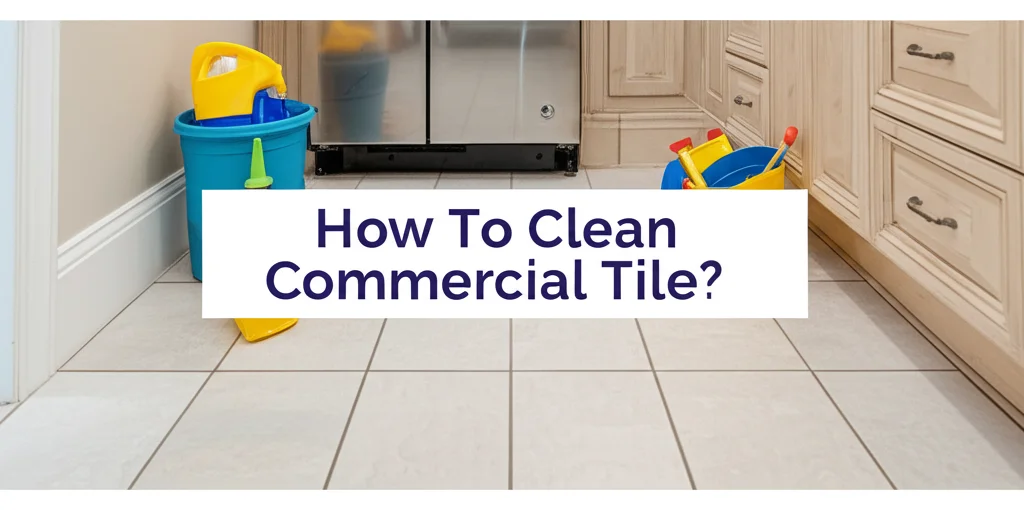· Commercial Cleaning · 12 min read
How To Clean A Commercial Kitchen Floor

The Ultimate Guide to Cleaning Commercial Kitchen Floors: Expert Methods for Spotless Results
Quick Takeaway:
- Commercial kitchen floors require daily cleaning and regular deep cleaning
- Different floor types need specific cleaning approaches and products
- Proper tools, chemicals, and techniques are essential for safety and sanitation
- Preventative maintenance extends floor life and reduces slip hazards
- Professional cleaning machines offer superior results for large spaces
A clean commercial kitchen floor is crucial for safety, sanitation, and regulatory compliance. Properly maintaining these high-traffic areas requires specialized knowledge of floor types, cleaning agents, and efficient techniques to handle grease, food debris, and heavy soil buildup.
Understanding Commercial Kitchen Floor Challenges
Commercial kitchen floors endure extreme conditions that residential floors rarely face. From heavy foot traffic to grease splatters, food debris, and constant moisture, these surfaces require specialized cleaning approaches to maintain both safety and sanitation standards.
The stakes are particularly high in commercial settings. Health inspectors scrutinize floor cleanliness during visits, and customers may glimpse your kitchen floor when passing by. More importantly, slippery floors represent one of the leading causes of workplace accidents in restaurant environments, making proper cleaning not just about appearance but about staff safety.
Different commercial kitchens face unique challenges. Quick-service restaurants deal with high volumes of grease and food particles, while hotel kitchens might experience round-the-clock use. Institutional kitchens in schools or hospitals must maintain strict sanitation protocols while balancing budget constraints for cleaning supplies.
Before diving into specific cleaning methods, it’s important to understand what makes commercial kitchen floor cleaning distinct from regular floor maintenance. The combination of food oils, cooking residue, and constant moisture creates a perfect environment for stubborn grime that ordinary cleaning products simply can’t tackle effectively.
Common Floor Types in Commercial Kitchens
The specific cleaning approach you’ll need depends largely on your floor material:
- Quarry Tile: Popular for its slip resistance and durability, quarry tile often features anti-microbial grout lines that require special cleaning attention
- Vinyl Composition Tile (VCT): Less expensive but requires regular stripping and waxing to maintain appearance
- Epoxy Flooring: Seamless and highly resistant to chemicals, but can be damaged by certain harsh cleaners
- Polished Concrete: Becoming more common for its industrial look and durability, but requires specific pH-neutral cleaners
- Commercial-Grade Vinyl: Modern option offering good slip resistance and easier maintenance than traditional materials
Identifying your floor type is the crucial first step in developing an effective cleaning protocol that won’t damage surfaces while still providing the deep clean necessary for commercial food environments.
Essential Cleaning Tools and Supplies
Properly cleaning a commercial kitchen floor requires having the right tools on hand. Unlike home kitchen cleaning, commercial environments demand industrial-strength equipment designed for heavy-duty use.
Basic Hand Tools
Every commercial kitchen should have these fundamental cleaning tools:
- Commercial deck brush with stiff bristles specifically designed for grout lines
- Heavy-duty squeegee for directing water toward floor drains
- Microfiber mops that trap more particles than traditional string mops
- Color-coded buckets to prevent cross-contamination between cleaning solutions
- Extendable handles to reach under heavy equipment
- Wet floor signs to prevent slip-and-fall accidents during cleaning
Commercial Floor Cleaner Options
Selecting the right cleaning solution is critical for breaking down kitchen grease without damaging your specific floor type:
- Alkaline degreasers (pH 10-12) for heavy grease buildup
- Neutral cleaners (pH 7-8) for daily maintenance
- Sanitizing solutions that meet health department requirements
- Enzymatic cleaners that break down protein-based food residues
How to clean stainless steel in a commercial kitchen demonstrates similar principles of matching the right cleaner to the surface material.
Many operations find that commercial floor cleaner concentrates offer better value than pre-mixed solutions, allowing staff to adjust strength based on cleaning needs. Products like Zep Floor Cleaner have become industry standards for their effectiveness on commercial surfaces.
Mechanical Cleaning Equipment
For larger kitchen spaces, investing in mechanical cleaning equipment can dramatically improve efficiency:
- Auto-scrubbers combine washing, scrubbing and vacuum drying in one pass
- Steam cleaners provide chemical-free sanitizing for grout and crevices
- Pressure washers (when floor drains permit) for deep cleaning sessions
- Industrial vacuum systems for dry debris removal before wet cleaning
A kitchen floor cleaner machine can reduce cleaning time by up to 75% compared to manual methods, making them cost-effective despite the initial investment.
Daily Cleaning Procedures for Commercial Kitchen Floors
Daily floor maintenance forms the foundation of any successful commercial kitchen cleaning program. Implementing a consistent daily routine prevents buildup and makes deeper cleaning sessions more manageable.
Beginning of Shift Preparation
Start each day with these preliminary steps:
- Clear the floor of any movable items like trash cans and rubber mats
- Sweep thoroughly using a stiff-bristle broom to remove loose debris
- Pay special attention to corners, under equipment, and along baseboards
- Remove stuck-on food particles using a scraper tool if necessary
Mid-Shift Spot Cleaning
During busy service periods, address spills immediately:
- Wipe up grease spills promptly using disposable towels
- Clean liquid spills with a designated mop to prevent cross-contamination
- Use dry absorbent compounds for oil spills before wet cleaning
- Always place wet floor signs during spot cleaning
End-of-Day Deep Cleaning
The most thorough cleaning should occur after closing:
- Remove all portable equipment from areas to be cleaned
- Pre-treat heavily soiled areas with appropriate degreaser
- Allow degreaser to dwell for manufacturer-recommended time (typically 5-10 minutes)
- Scrub floor using a deck brush, focusing on grout lines and corners
- Rinse thoroughly with clean water to prevent chemical residue
- Squeegee excess water toward floor drains
- Allow floor to air dry completely before replacing equipment
For especially oily floors, you may need to repeat the degreasing process in high-traffic cooking areas.
Restaurant managers should create a daily cleaning checklist that staff members initial upon completion, ensuring accountability and consistent results. This documentation can also prove valuable during health inspections.
How to Deep Clean a Commercial Kitchen Floor
While daily cleaning addresses surface-level soiling, periodic deep cleaning is essential for removing accumulated grime, sanitizing thoroughly, and maintaining floor integrity. Most commercial kitchens benefit from weekly deep cleaning sessions in addition to daily maintenance.
Pre-Deep Cleaning Preparation
Begin with these preliminary steps:
- Schedule deep cleaning during off-hours when kitchen is completely closed
- Remove all movable equipment including prep tables and storage racks
- Protect immovable equipment with plastic sheeting
- Ensure proper ventilation by opening windows or activating exhaust systems
- Gather all necessary supplies before beginning
Step-by-Step Deep Cleaning Process
Follow this comprehensive process for truly deep cleaning results:
Remove loose debris
- Sweep thoroughly using a stiff broom
- Use compressed air to blow out debris from cracks and corners
- Vacuum with a shop vacuum to remove remaining particles
Apply heavy-duty degreaser
- Select an appropriate restaurant floor cleaning chemical for your floor type
- Dilute according to manufacturer instructions for heavy soil
- Apply liberally using a mop or pump sprayer
- Allow proper dwell time (10-15 minutes) for chemicals to break down grease
Scrub aggressively
- Use a floor machine with appropriate scrubbing pad
- For areas without machine access, use a deck brush with stiff bristles
- Pay special attention to grout lines, corners, and areas near cooking equipment
- Scrub in overlapping patterns to ensure complete coverage
Rinse thoroughly
- Use clean, hot water for rinsing
- Change rinse water frequently to prevent redepositing soil
- Consider a second rinse for heavily soiled areas
- Use a wet vacuum to remove rinse water if floor drainage is limited
Sanitize the surface
- Apply food-safe sanitizer according to health department requirements
- Ensure proper dilution and contact time
- Allow floor to air dry completely
Inspect and touch up
- Examine floor under good lighting
- Address any remaining soil or stains
- Pay particular attention to areas around equipment and corners
Learning how to clean greasy kitchen floor tiles may require experimentation with different cleaning agents and techniques until you find the most effective combination for your specific floor material and soil conditions.
Specialized Cleaning for Different Floor Types
Different commercial kitchen flooring materials require specialized cleaning approaches to maintain appearance and function while avoiding damage. Understanding your specific floor type is essential for selecting appropriate cleaning methods and chemicals.
Quarry Tile and Grout
This traditional commercial kitchen flooring presents unique challenges:
- Use a two-step cleaning process: alkaline degreaser followed by acid-based cleaner
- Clean grout lines using a narrow brush designed specifically for grout
- Consider steam cleaning for deep sanitizing without chemicals
- Seal grout periodically to prevent staining and bacterial growth
- Test cleaning solutions in inconspicuous areas first
Epoxy and Resin Floors
Modern seamless floors require gentler treatment:
- Avoid harsh acids that can damage resin surfaces
- Use pH-neutral cleaners for daily maintenance
- Address spills immediately to prevent staining
- Soft-bristle brushes prevent surface scratching
- Look for cleaners specifically formulated for resin floors
Vinyl Composition Tile (VCT)
This economical option requires regular maintenance:
- Strip and rewax periodically to maintain appearance
- Use only recommended cleaners to avoid compromising wax layers
- Avoid excessive water that can seep between tiles
- Machine buffing restores shine between waxing
- Address scuffs promptly with appropriate cleaners
Non-Slip Safety Floors
Specialized textured floors need particular attention:
- Use brushes rather than mops to clean textured surfaces effectively
- Select cleaners that won’t compromise non-slip properties
- Rinse thoroughly to prevent chemical buildup in textured areas
- Consider specialized heavy duty floor cleaner machines with cylindrical brushes
Understanding your floor manufacturer’s cleaning recommendations helps prevent accidental damage while ensuring proper maintenance. Many flooring warranties require specific cleaning protocols to remain valid.
Tackling Stubborn Stains and Problem Areas
Even with regular cleaning, commercial kitchen floors develop challenging stains and problem areas that require specialized treatment. Addressing these issues promptly prevents permanent damage and maintains a professional appearance.
Common Stain Types and Solutions
Different stains require specific treatments:
Grease Stains
- Apply poultice of baking soda and degreaser
- Allow to dry completely before scrubbing
- For persistent grease, try commercial-grade orange oil cleaners
Rust Stains
- Use oxalic acid-based cleaners (with proper ventilation)
- Apply with non-metal scrubbing pad
- Rinse immediately and thoroughly
Food Dye Stains
- Try hydrogen peroxide for organic stains
- Use sodium percarbonate for stubborn colors
- Test in inconspicuous area first
Mineral Deposits
- Apply vinegar or commercial lime remover
- Allow to dwell 5-10 minutes
- Scrub with non-scratch pad
- Rinse thoroughly
Addressing Damaged Areas
Physical floor damage requires more than cleaning:
- Fill cracked grout with epoxy grout repair products
- Patch damaged tile with matching material
- Replace severely damaged sections rather than attempting repair
- Address floor damage promptly to prevent safety hazards
Equipment Areas and Corners
These notoriously difficult areas require special attention:
- Use degreasing foam that clings to vertical surfaces around equipment
- Employ extendable cleaning tools to reach under heavy appliances
- Schedule quarterly equipment pulls for thorough cleaning underneath
- Clean floor drain covers daily and deep clean drains weekly
Finding information on how to clean a commercial ice maker can provide additional insights into cleaning around fixed equipment.
Preventative Maintenance and Ongoing Care
Implementing preventative measures significantly reduces cleaning time and extends floor life. A proactive approach to floor maintenance creates a safer working environment while optimizing cleaning efficiency.
Preventative Measures
Reduce soil load with these practical steps:
- Install proper entrance matting to capture dirt before it enters the kitchen
- Use anti-fatigue mats in cooking areas to catch grease splatter
- Implement proper waste management to minimize food debris
- Train staff on immediate spill response procedures
- Install splashguards around high-grease equipment
Cleaning Schedule Development
Create a comprehensive cleaning program:
Daily Tasks:
- Sweep and mop entire kitchen floor
- Spot clean spills immediately
- Clean floor drain covers
Weekly Tasks:
- Deep clean high-traffic areas
- Scrub grout lines
- Clean under movable equipment
Monthly Tasks:
- Complete deep cleaning of entire floor
- Machine scrubbing of textured surfaces
- Grout sealing inspection
Quarterly Tasks:
- Pull fixed equipment for underneath cleaning
- Evaluate floor condition for repairs
- Deep clean drains and plumbing access points
Staff Training Elements
Effective floor maintenance requires proper training:
- Chemical safety and OSHA compliance
- Proper dilution of cleaning concentrates
- Equipment operation procedures
- Slip-and-fall prevention protocols
- Cleaning validation methods
Implementing a best industrial floor cleaner liquid rotation system can help prevent bacterial resistance while addressing seasonal cleaning challenges.
Professional Cleaning Services and Equipment
While daily maintenance can be handled in-house, many commercial kitchens benefit from periodic professional cleaning services and specialized equipment for deeper results.
When to Consider Professional Services
Professional floor cleaning may be appropriate:
- Quarterly for deep extraction cleaning
- When preparing for health inspections
- After major kitchen renovations
- To address persistent staining issues
- For restorative cleaning of neglected floors
Equipment Investment Considerations
When evaluating heavy duty floor cleaner machines:
- Compare purchase versus rental costs
- Consider storage space requirements
- Evaluate staff training needs
- Factor in maintenance expenses
- Look for versatile equipment that works on multiple surfaces
Latest Cleaning Technology
Modern innovations improve cleaning efficiency:
- Microfiber technology that removes more bacteria with less water
- Electrostatic sprayers for even sanitizer application
- ATP monitoring systems to verify cleaning effectiveness
- Low-moisture cleaning systems that reduce dry time
- Environmentally friendly enzyme cleaners that continue working after application
Understanding the best way to clean a kitchen floor often involves combining traditional methods with new technology for optimal results.
Frequently Asked Questions About Commercial Kitchen Floor Cleaning
How do you deep clean a commercial kitchen floor?
Deep cleaning requires removing all movable equipment, applying appropriate degreaser, allowing proper dwell time, aggressive scrubbing with mechanical assistance when possible, thorough rinsing, and proper sanitizing. The process takes significantly longer than daily maintenance but should be performed weekly in busy operations.
What is the best floor cleaner for a commercial kitchen?
The best cleaner depends on your specific floor type and soil conditions. Generally, alkaline degreasers (pH 10-12) work best for breaking down cooking oils, while neutral cleaners are better for daily maintenance. Always verify compatibility with your specific flooring material before applying new chemicals.
How do you clean dirty commercial floors efficiently?
Efficiency comes from proper preparation, appropriate tools, and systematic approach. Pre-sweeping thoroughly, using the right chemical concentration, allowing proper dwell time, using mechanical scrubbing when possible, and working in manageable sections all improve cleaning efficiency.
How often should commercial kitchen floors be cleaned?
Commercial kitchen floors should receive basic cleaning daily, with spot cleaning throughout shifts. Deep cleaning should occur weekly, with more intensive restorative cleaning monthly or quarterly depending on traffic and soil conditions. Health department regulations may specify minimum cleaning frequencies.
How do you clean greasy kitchen floor tiles?
Greasy tiles require alkaline degreasers specifically formulated to break down lipids. Apply the solution, allow 10-15 minutes dwell time (without drying), aggressively scrub with appropriate brushes, and rinse thoroughly. For extremely greasy conditions, a two-step process using degreaser followed by neutral cleaner provides superior results.
What safety precautions should be taken when cleaning commercial kitchen floors?
Always use appropriate personal protective equipment including chemical-resistant gloves and eye protection. Ensure proper ventilation, post wet floor signs, use non-slip footwear, and follow all chemical safety guidelines. Never mix cleaning chemicals, particularly those containing bleach and ammonia.
Final Thoughts on Commercial Kitchen Floor Maintenance
Maintaining commercial kitchen floors requires consistent effort, appropriate tools, and systematic processes. The investment in proper floor care delivers significant returns through improved safety, health compliance, and extended floor life.
Clean floors aren’t just about aesthetics—they’re fundamental to kitchen safety. Slip-and-fall accidents represent a significant liability risk that proper floor maintenance directly addresses. Additionally, properly maintained floors resist bacterial growth that could compromise food safety.
Creating a documented cleaning program with clear responsibilities and validation procedures ensures consistent results even with staff turnover. Consider incorporating floor cleaning verification into daily management walkthroughs to reinforce its importance.
Remember that different areas of your kitchen may require different cleaning approaches based on specific soil challenges. Cooking line floors typically need more frequent degreasing, while prep areas may require more attention to food particle removal. Customize your approach to address your operation’s unique needs.
By implementing the comprehensive cleaning approaches outlined in this guide, you’ll create a safer, more sanitary kitchen environment that meets regulatory requirements while projecting professionalism to staff and guests alike.
For more information on maintaining other aspects of your commercial kitchen, explore our guides on how to clean a commercial oven and how to clean a commercial dishwasher.
- commercial kitchen cleaning
- kitchen floor cleaning
- restaurant floor cleaning




